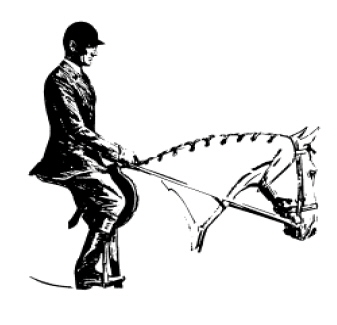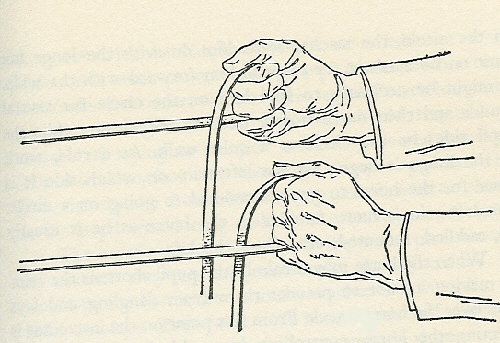IMEHA (International Model Equine Hobbyists Association) was an online photo showing site that existing until 2018. Included on the site were these guidebooks for judging and showing model horses in Performance classes. MEPSA has obtained permission to share the info contained in the guides.
Scoring :: Point Deducts :: Tack :: Rider :: Set-Up Options :: Photo Examples
A jump or water hazard is required for this class.
Speed and skill event to display the prowess of stadium jumping. Courses are eight to fifteen fences and a specific time frame is given. Horses may compete at any gait as long as fences are cleared in the correct order and within the allowed time. The course begins with a horse and rider halted in the ring and saluting the judge. The rider and horse then begin at a canter and perform a courtesy circle.
No cross entering from Hunter Hack, Hunter Over Fences, Hunter Pace, Hunter Under Saddle or Handy Hunter Classes.
You Score Show or Stadium Jumping on the following basis:
Arena Arrangement:
(1) There is a minimum of four obstacles; horses are to make a minimum of eight jumps.
(2) A spread fence consisting of two or more elements will be mandatory.
(3) It is recommended the first obstacle be no more than minimum height.
(4) Optional obstacles may include:
(A) Post and Rail (at least two)
(B) Chicken Coop
(C) Stone Wall
(D) Triple Bar
(E) Brush Jump
(5) Both a starting line at least 12 feet (3.6 meters ) in front of the first obstacle, and a finish line at least 24 feet (7.3 meters) beyond the last obstacle must be indicated by markers (at least 12 feet (3.6 meters) apart) at each end of the lines. Horse must start and finish by passing between markers.
(6) Obstacles, except within combinations, should be located a minimum distance of 48 feet (14.6 meters) apart, size of arena permitting.
(7) Height of obstacles must be a minimum of three feet six inches and a maximum of four feet (122 cm) in first go-round, except in youth and amateur which is a minimum of three feet three inches (99 cm) and a maximum of three feet six inches (105 cm).
(c) Time shall begin from the instant the horse’s chest reaches the starting line until it reaches the finish line. Time shall be stopped while a knocked down jump is being replaced, this is from the moment the rider gets his mount in a position to retake the jump until the proper authority signals that the jump has been replaced. It shall be the rider’s responsibility to be ready to continue the course when the signal is given.
(d) Scoring: jumpers are scored on a mathematical basis and penalty faults which include knockdowns, disobediences and faults.
(1) Knockdown: An obstacle is considered knocked down and four faults assessed, when a horse or rider, by contact:
(A) Lowers any part thereof which establishes the height of the obstacle or the height of any element of a spread obstacle even when the falling part is arrested in its fall by any portion of the obstacle; or
(B) Moves any part thereof which establishes the height of the obstacle so it rests on a different support from the one on which it was originally placed;
(C) Knocks down an obstacle, standard wing, automatic timing equipment or other designated markers on start and finish lines.
(D) If an obstacle falls after the horse leaves the ring, it shall not be considered a knockdown.
(2) Disobediences:
(A) Refusal: When a horse stops in front of an obstacle (whether or not the obstacle is knocked down or altered) it is a refusal unless the horse then immediately jumps the obstacle without backing one step. If horse takes one step backwards, it is a refusal.
(1) After a refusal, if horse is moved toward the obstacle but does not attempt to jump, it is considered another refusal.
(2) In the case of a refusal on an in-and-out jump, the horse must return to the start of the in-and-out sequence and rejump previous elements as well as following elements.
(B) Run-out: A run-out occurs when the horse evades or passes the obstacle to be jumped; jumps an obstacle outside its limiting markers; or when the horse or rider knocks down a flag, standard, wing or other element limiting the obstacle (without obstacle being jumped).
(C) Loss of forward movement: Failure to maintain trot, canter or gallop after crossing starting line, except when it is a refusal, a run-out or when due to uncontrollable circumstances, such as when an obstacle is being reset.
(D) Unnecessary circling on course: Any form of circle or circles, whereby the horse crosses its original track between two consecutive obstacles anywhere on course, except to retake obstacle after refusal or run-out.
(E) First disobedience anywhere on course – four (4) faults.
(F) Second cumulative disobedience anywhere on course – (refusal) elimination
(G) Jumping an obstacle before it is reset, or without waiting for signal to proceed.
(H) Starting before judges signal to proceed.
(I) Failure to enter ring within one minute of being called.
(J) Failure to cross the starting line within 45 seconds after an audible signal to proceed.
(K) Jumping an obstacle before crossing start line unless said obstacle is designated as a practice obstacle, or after crossing the finish line, whether forming part of the course or not.
(L) Off course.
(M) Rider and/or horse leaving the arena before finishing the course (penalized at any time the horse is in the ring).
(N) Excessive use of a whip, rope, crop, bat or reins anywhere on the horse.
(4) In cases of broken equipment, the rider may either continue without penalty or stop and correct difficulty, in which case he /she will be penalized four faults. In case of loss of shoe, rider may continue without penalty or be eliminated.
If You Use A Doll Rider:
Rider should have a workmanship appearance, seat and hands, light and supple. Hand should be over and in front of horse’s withers, knuckles 30 degrees inside the vertical, hand slightly apart and making a straight line from the horse’s mouth to rider’s elbow. Method of holding reins is optional. All reins are to be picked up at the same time. Eyes should be up with shoulders back, toes slightly out and ankles flexed in. Heels should be down and calf or leg in contact with horse and slightly behind girth.
The rider should sit in a comfortable, balanced, and relaxed manner while maintaining an erect upper body with eyes up and looking forward.
The rider’s legs should have a slight bend and hang beneath the rider such that when viewed from a profile, a straight line (approximately) can be drawn through the rider’s ear, shoulder, hip and heel.
The irons should be placed under the balls of the feet and not under the toe or against the heel.
Toes should be turned only slightly out with ankles flexed in toward the horse.
The lower leg should be held such that light contact would be maintained with the horse.
Arms and hands should be held in a comfortable, relaxed manner with upper arms held in a straight line with the body. The elbow is bent such that the lower arm and hands are in a straight line to the bit.
Hands should be slightly over and in front of the withers with knuckles 30 degrees inside the vertical.
Position in Motion;
At the walk and slow trot, body should be vertical with slight motion in the saddle.
At a posting trot, the body should be inclined forward with slight elevation in the saddle.
At the canter, the body should be halfway between the posting trot and the walk.
At the gallop, and while jumping, the body should be at a similar inclination as when at a posting trot.
Extra Credit Should Be Given If:
(1) Sweat or lather on the chest, behind the ears, and on the side of the neck where reins would rub
(2) Additional tack elements such as belly protectors shadow rolls, ear nets, etc.
(3) European jumpers often wear their numbers on a tag put on bridle at the browband and crownpiece junction.
(4) Well-fitted protective boots.
(5) Accurate, elaborate jump.
(6) Bight (Excess rein) of rein is draped on the right.
(7) Entry Number is shown on saddle blanket or on rider’s back.
Points Should Be Deducted If:
(1) Model’s head is carried too high.
(2) Model displays excessive nosing out.
(3) Model displays an open mouth excessively.
(4) Rider uses spurs forward of the cinch.
(5) Model appears sullen, dull, lethargic, emaciated, drawn or overly tired.
(6) Reins are draped and not a direct contact.
Required Tack:
Any type goes and there are no restrictions of any kind for jumpers unless it is cruel or unsafe tack.
Forward seat (jumping saddle)either:
Close Contact
Eventing
All-purpose
Saddles are usually of brown leather, with a plain girth, usually of leather.
Snaffle bit, either a dee-ring, eggbutt, or full cheek design.
Pelham bits which include a curb chain and require two sets of reins are also legal
Flash or figure 8 nosebands are permitted.
Running martingales are common, Gag snaffles, mechanical hackamores, unique bits are allowed.
Horses wear protective boots on the forelegs and sometimes on the hind. Belly protectors, breastplates, and colored saddlepads are also used. Horses are generally not braided but there is no rule against it.
Prohibited Tack:
Standing Martingales are forbidden.
Rider:
Attire should be black, brown, scarlet, brown tweed, dark green or navy hunt coat, light colored shirt with choker (stock pins optional; monograms fashionable) light colored or white breeches with full boots or beige or canary jodhpurs with jodhpur boots. Black hard hat, any long hair should be tied up in a bun or hairnet. All participants wear black hard hats (tweed caps are permissible only if entry is historic), junior riders have the ribbons at the back of the hard hat. Attire may also be of a school uniform such as French Officer Training School uniform, Spanish Riding School, Oxford Academy, or Canadian Mountie. These uniform consists of uniform coat, beeches, full riding boots, and the style of cap or hat worn by that school. It is suggested when using doll riders wearing these type of uniforms that the photo have a comment line used.
Jumps:
Obstacles are generally bright in color and very creative. They may be decorated with corporate logos, flowers, themes, etc. Obstacles should have at least one element that can be knocked down or off with the exception of a water element. Fences are numbered in the order they are to be jumped from two directions on the same course. Fences are flagged with red on the right and white on the left. Jumps heights are anywhere from 2′ 6″ for novice and ponies to 5′ 6″ for Grand Prix level. Bigger walls may be used for Puissance. Spread fences will have rear element (a single pole usually) even with or higher than the front, unless there is a large disparity in height between front and back elements.
Set-Up Options:
Arena Fencing Required (Indoor or Outdoor Arena)
Types of Fencing Allowed:
- Painted or Natural
- Post and Rail
- Post and Plank
- Chain Link
- Solid Plyboard
- Plyboard with Top Rail
- Post with Drape Rope
- Stock Tube Pipe Rail
- Interior Arena Wall
Footing Required:
- Dirt
- Sand
- No rock base
Backboard or Natural Setting (Indoor or Outdoor)
A jump is required in photo.
Examples of Show or Stadium Jumping Entries:
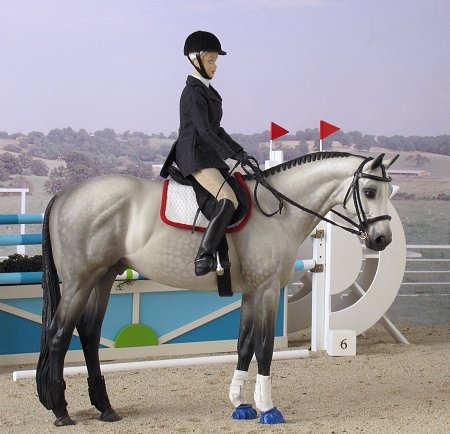
Jumping – Standing Horse Entry
Visionary shown as a Gray Thoroughbred gelding and is a Venator. Shown by Andrea Robbins with the comment: EVENTING: JUMPING TEST: Entrant has entered the arena and is awaiting the judge’s signal to proceed.
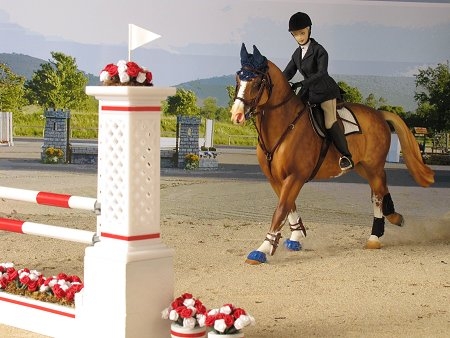
Jumping – Cantering Toward Jump Entry
The Golden Beast shown as a Dappled Palomino Dutch Warmblood x Irish Draught cross gelding and is a Mittens mold. Shown by Andrea Robbins with the comment: SHOW JUMPER: Approaching the next fence on the Jumper course
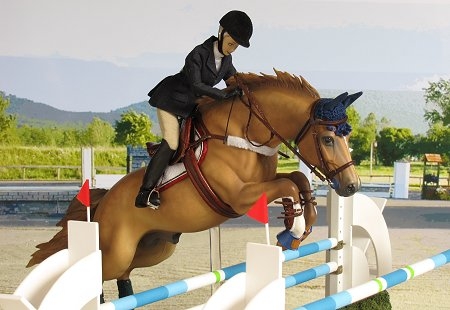
Jumping – Jumping Horse Entry
Aer Charmed Life shown as a Chestnut Hanoverian Stallion and is a CM Breyer Jumper by Jen Read. Shown by Andrea Robbins with the comment: Jumping the next fence in the Jumper class. Rider has a number on her back, and she is holding a crop.

Jumping – Hand Gallop Toward Fence Entry
Bettetowin shown as a Dark Chestnut Thoroughbred Mare and is a CM Ruffian by Tammy Lee Mayberry, Shown by Andrea Robbins with the comments: Lining up for the next obstacle in the Jumper Test portion of Eventing (in which a twead coat is allowed).
Doll Rider Correct Seat and Hold the Reins Correctly:

The reins are held between the ring fingers and pinkies with the thumbs solidly on top as they exit the hands. The grip is firm. Close the fingers for optimum communication and safety. Hold the hands just above the horse’s withers, in front of the saddle. Tip the thumbs toward each other at a 45-degree angle. Bend the elbows just enough to create a straight line through the forearms, hands, and reins to the horse’s mouth.
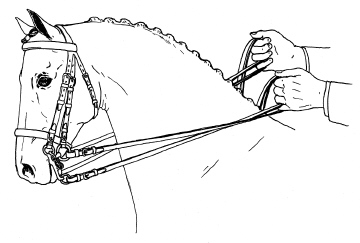
Double Bridle Reins – 2 and 2 Method. Most common handle hold in model horse hobby. It is advised that you put in your comment line what hold your set up is so that judge’s know you understand the three styles on holding the reins.

Double Bridle Reins – 3 in 1 Method. A true challenge for model horse hobbyists and doll rider’s with razor cut slips in the fingers of the hands. Left side curb goes directly back to hand and enters under ring finger with the left snaffle rein coming directly back and entering under the pinky finger with rein crossing over the curb rein. Right side curb rein goes directly back and enters under the middle finger of the left hand with all three reins coming up thru hand and out over the of the index finger with bight cascading down the right side. The right side snaffle goes directly and enters the hand under the ring finger, up into the hand and out over the top of the index finger with the bight draping down the right side. The look gives an ‘X’ to reins the left side of horse’s neck but a two independent rein look to the right side but only one rein going into the right hand. Very tricky set up.
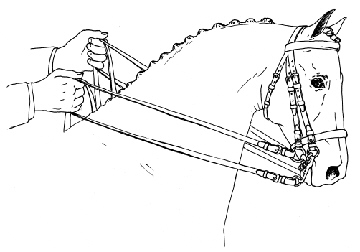
Double Bridle Reins – Fillis Method. The Fillis method of holding the reins is when the curb reins enter the rider’s hand from the bottom, around the little fingers and up to the second joint of the index fingers while the snaffle enters the fist from above over the index fingers. Each hand holds two reins.

